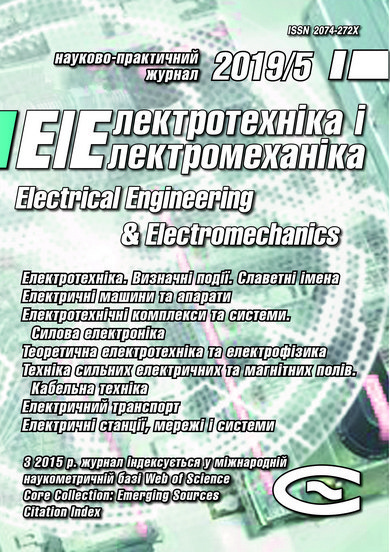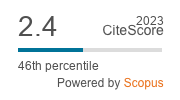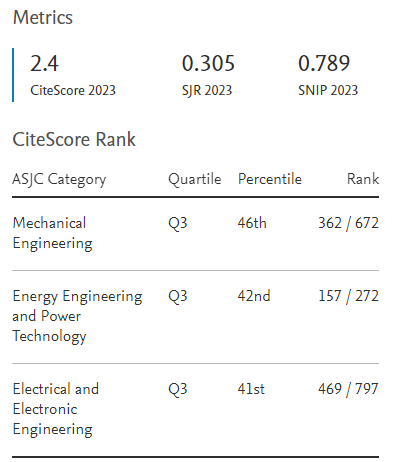APPLICATION OF MAGNETORHEOLOGICAL ELASTOMERS FOR PERFORMANCE CONTROL OF CUSHIONING SYSTEMS FOR WHEELED VEHICLES
DOI:
https://doi.org/10.20998/2074-272X.2019.5.09Keywords:
magnetorheological elastomer, control magnetic field, modulus of elasticity, loss modulus, wheeled vehicle, cushioning system, elastic hinges, suspension performance controlAbstract
The purpose of the work is to study the influence of the control of the elastic and damping characteristics of the cushioning system based on the use of magnetorheological elastomers on the smoothness of the course of wheeled transport vehicles. The technique. The research used the methods of: magnetic field theory, the theory of vehicle suspension, experiment theory planning, and the FEMM code for studying magnetic field characteristics and mathematical modeling of wheeled vehicle movement along roughness in the Delphi environment. Results. Designed, researched and patented designs of elastic hinges of the suspension arms with magnetorheological elastomers. The relative boundaries of changes in the elastic modules and losses of these hinges are determined when controlling the characteristics of the suspension in order to improve the smoothness of the wheeled vehicle. Scientific novelty. For the first time, the feasibility of using magnetorheological elastomers to control the elastic and damping characteristics of the cushioning system of wheeled vehicles has been investigated, and the requirements for control laws have been determined, which make it possible to increase smoothness by more than 40 %; it is established that the control of the loss modulus has a greater effect on the improvement of smoothness of motion than the control of the elastic modulus. Practical value. The design has been developed and the relative boundaries of changes in the modules of elasticity and loss of hinges with magnetorheological elastomers during their control have been determined, which will make it possible to formulate requirements for elastomers when developing promising hinge designs for vehicle suspension systems.References
Ginder J.M., NicholsM.E., Elie L.D., Tardiff J.L. Magnetorheological elastomers: properties and applications. Proceeding of SPIE, 1999, vol.3675, pp. 131-138.
Lokander M., Stenberg B. Performance of isotropic magnetorheological rubber materials. Polymer Testing, 2003, vol.22, no.3, pp. 245-251. doi: 10.1016/s0142-9418(02)00043-0.
Jolly M.R., Carlson J.D., Muñoz B.C., Bullions T.A. The magnetoviscoelastic response of elastomer composites consisting of ferrous particles embedded in a polymer matrix. Journal of Intelligent Material Systems and Structures, 1996, vol.7, no.6, pp. 613-622. doi: 10.1177/1045389x9600700601.
Li W.H., Zhang X.Z., Du H. Magnetorheological elastomers and their applications. Book Chapter in Advanced Structured Materials, 2013, vol.I, pp. 357-374. doi: 10.1007/978-3-642-20925-3_12.
Böse H., Röder R. Magnetorheological elastomers with high variability of their mechanical properties. Journal of Physics: Conference Series, 2009, vol.149, p. 012090. doi: 10.1088/1742-6596/149/1/012090.
Gorbunov A.I., Mikhailov V.P., Stepanov G.V., Borin D.Yu., Adrianov A.A., Temnov D.V., Semerenko D.A. Investigation of properties and new application of magnetic silicon composites. Herald of the Bauman Moscow State Technical University. Series Mechanical Engineering, 2008, no.1(70), pp. 90-107. (Rus).
Mihailov V.P., Shakov K.G, Selivanonko A.S., Bazinenkov A.M. Vibration isolation control in precision equipment. Science and Education of the Bauman MSTU, 2012, vol.12, no.9, pp. 1-12. (Rus). doi: 10.7463/0912.0454475.
Chen L., Gong X.L., Li W.H. Microstructures and viscoelastic properties of anisotropic magnetorheological elastomers. Smart Materials and Structures, 2007, vol.16, no.6, pp. 2645-2650. doi: 10.1088/0964-1726/16/6/069.
Gong X.L., Chen L., Li J.F. Study of utilizable magnetorheological elastomers. International Journal of Modern Physics B, 2007, vol.21, no.28n29, pp. 4875-4882. doi: 10.1142/s0217979207045785.
Duschenko V.V., Masliev A.O. Research of the magnetic field and the choice of the construction of an elastic joint with the sleeve of the magnetorheological elastomer suspension of wheeled armored vehicle. Bulletin of NTU «KhPI». Series: Transport machine building. – 2017. – no.5(1227). – pp. 173-178. (Ukr).
Available at: https://www.google.com/search?q=кривые+намагничивания+ферромагнитных+материалов&rlz=1C2JZAP_ruUA747UA755 (accessed 20 May 2018).
Krautz M., Werner D., Schrödner M., Funk A., Jantz A., Popp J., Eckert J., Waske A. Hysteretic behavior of soft magnetic elastomer composites. Journal of Magnetism and Magnetic Materials, 2017, vol.426, pp. 60-63. doi: 10.1016/j.jmmm.2016.11.048.
Dushhenko V.V, Maslіev A.O. Improvement of the construction of hinge using magnetorheological elastomers of lever of controled suspension of the vehicle. Mechanics and mechanical engineering, 2017, no.1, pp. 90-97. (Ukr).
Dushhenko V.V, Maslіev A.O. Pidviska z regulyuvannyam zhorstkosti ta dempfiruvannya [Suspension with adjustable stiffness and damping]. Patent UA, no.110476, 2016. (Ukr).
Maslіev A.O., Dushhenko V.V., Ljubarskij B.G., Maslіev V.G. Pidviska transportnogo zasobu [Vehicle suspension]. Patent UA, no.115131, 2017. (Ukr).
Duschenko V.V., Masliev A.O. Stand for experimental study of the effect of magnetic field on the elastic modulus and a module of losses of magnetorheological elastomers. Bulletin of NTU «KhPI». Series: Transport machine building, 2018, no.29(1305), pp. 46-50. (Ukr).
Maslіev A.O., Dushhenko V.V., Maslіev V.G. Stend dlia doslidzhennia vplyvu mahnitnoho polia na kharakterystyky zhorstkosti, dempfiruvannia ta modul pruzhnosti mahnitoreolohichnykh elastomeriv [A stand for studying the influence of a magnetic field on the characteristics of stiffness, damping, and the elastic modulus of magnetorheological elastomers]. Patent UA, no.128767, 2018. (Ukr).
Kallio M. The elastic and damping properties of magnetorheological elastomers. VTT Publications, 2005. 149 pp.
Pankov A.A. Magnetodeformation effect of an elastomer with magnetized polydisperse spherical inclusions. Journal of Radio Electronics, 2015, no.4, 15 p. (Rus).
Dushhenko V.V., Maslіev A.O., Maslіev V.G. Sposib polipshennia plavnosti rukhu transportnoho zasobu [A method for improving the smoothness of the vehicle]. Patent UA, no.128458, 2018. (Ukr).
Aleksandrov E.E., Volontsevich D.O., Dushhenko V.V. Matematicheskoe modelirovanie processov vozmushhennogo dvizhenija agregatov i sistem bronetankovoj tehniki [Mathematical modeling of processes of disturbed movement of units and systems of armored vehicles]. Kharkiv, «KhPI» Publ., 2012. 354 p. (Rus).
Downloads
Published
How to Cite
Issue
Section
License
Copyright (c) 2019 V. V. Dushchenko, V. G. Maslіev, R. A. Nanivskyi, A. O. Maslіev

This work is licensed under a Creative Commons Attribution-NonCommercial 4.0 International License.
Authors who publish with this journal agree to the following terms:
1. Authors retain copyright and grant the journal right of first publication with the work simultaneously licensed under a Creative Commons Attribution License that allows others to share the work with an acknowledgement of the work's authorship and initial publication in this journal.
2. Authors are able to enter into separate, additional contractual arrangements for the non-exclusive distribution of the journal's published version of the work (e.g., post it to an institutional repository or publish it in a book), with an acknowledgement of its initial publication in this journal.
3. Authors are permitted and encouraged to post their work online (e.g., in institutional repositories or on their website) prior to and during the submission process, as it can lead to productive exchanges, as well as earlier and greater citation of published work.





